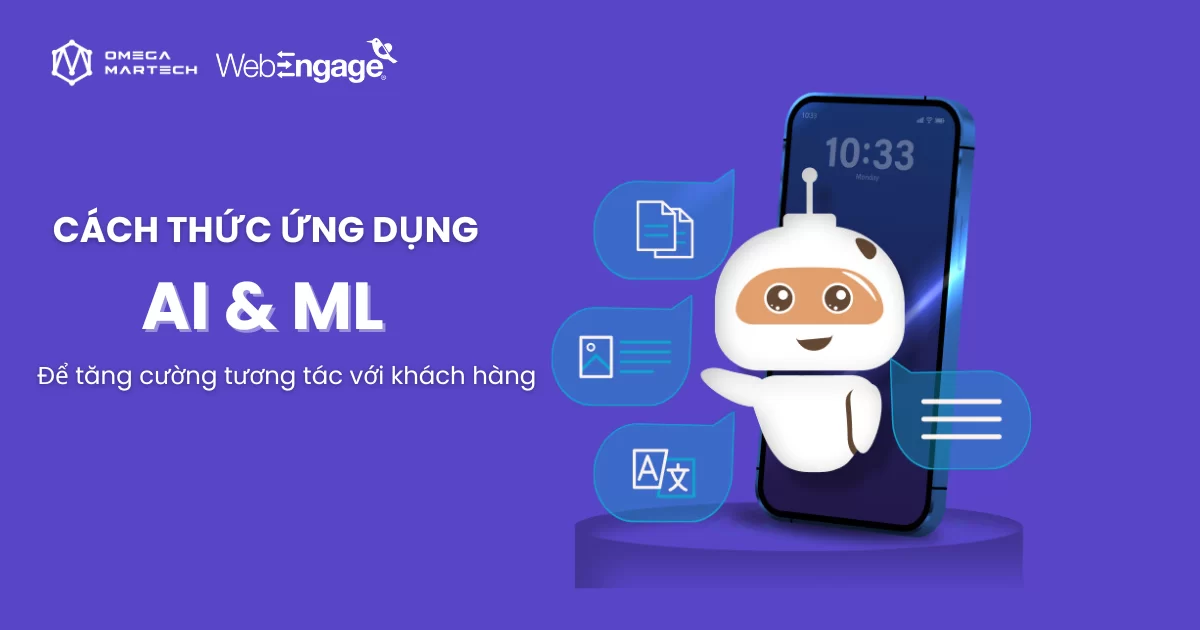“Innovation is at the core of corporate culture. Customers are changing constantly, and if we don’t keep up, we become obsolete and get into trouble” – lab Schafer
There is always fierce competition in the capital market. Therefore, to increase competitiveness and achieve success, businesses need to understand their customers. Only when they understand the desires and needs of customers, will businesses know how to attract and retain them. Businesses that create a stable, loyal customer base will create a sustainable source of revenue. Nowadays, in the digital age, businesses are constantly innovating and updating to keep up with customers and fully meet their needs.
You can easily gain a competitive edge and attract new guests while retaining your existing customer base through the power of Artificial Intelligence (AI) and Machine Learning (ML).
AI and ML are often used interchangeably, but they actually perform different tasks. Before diving into the specific features, Airbridge invites you to learn more about the definition.
Artificial Intelligence (AI): Simply put, AI is computer-controlled technology that is capable of performing tasks that humans would normally undertake. AI is a smart, responsive piece of technology.
Machine Learning (ML): Meanwhile, ML is an important branch of AI, focusing on using data and algorithms to make more accurate classifications and predictions.
When combined, these cutting-edge technologies have the potential to completely transform customer service operations, foster lasting relationships, and deliver amazing customer experiences.
Major companies like Amazon and Netflix are pioneers in using AI/ML integration strategies to analyze user preferences and behaviors, providing personalized product and viewing recommendations to each user segment, thereby boosting revenue and attracting more new subscribers.
Another great example is the AI used in Tesla’s Autopilot system, which helps ensure a safe autonomous driving experience. The system uses cameras, radar, and machine learning to detect vehicles, maintain speed, and change lanes when necessary. While the driver remains focused on the steering wheel, the AI system assists with steering, acceleration, and braking, making long trips more comfortable and enjoyable. The system is like a co-pilot who supports the driver on every journey.
In this article, we will explore how AI and ML can help businesses drive powerful customer engagement.
The Core of Customer Engagement
Before we discuss how Artificial Intelligence (AI) and Machine Learning (ML) can boost customer engagement, what is customer engagement? Customer engagement refers to the emotional relationship a customer has with a brand. It includes every interaction a customer has with your business, from the first visit to your website to post-purchase support services.
Customer engagement is closely linked to customer experience (CX) – the customer’s perspective and emotions during the interaction with your business. The diverse experiences of customers will create emotions between them and your business, the result of this process is customer engagement. When customers have positive, frequent and useful experiences, their interaction with the brand will also increase.
Positive customer interactions:
- Repeat purchase: Engaged customers come back to buy more products, resulting in higher customer lifetime value.
- Brand loyalty: They feel deeply attached to the brand and are less likely to choose a competitor's product/service.
- Referrals: Engaged customers become “brand ambassadors”, willing to proactively introduce products to friends, family and people around them.
- Feedback: They provide valuable feedback and suggestions, helping the company improve its products and services.
- User-Generated Content: Engaged customers often write reviews, social media posts, and positive testimonials, which become testimonials about your brand.
The Evolution of AI/ML in Customer Engagement
The evolution of Artificial Intelligence (AI) and Machine Learning (ML) in customer engagement has been an exciting journey marked by advances and significant impacts on businesses. These technologies have evolved from their infancy to become critical tools for understanding, interacting with, and meeting customer needs. According to a Pegasystems customer engagement survey, 100% of the top performing companies use AI. Additionally, 56% of the top performing companies report investing more in AI to personalize and continuously collect and analyze customer interactions. Let’s explore this evolution in more detail:
Early AI/ML Applications: In its early stages, AI and ML in customer engagement were simple, with basic chatbots and recommendation systems. Chatboxes could handle direct customer questions, while recommendation algorithms provided product suggestions based on previous purchase history.
Data augmentation: As the digital age has grown, the volume of customer data has skyrocketed. AI and ML have begun to play a pivotal role in processing and extracting valuable information and data in detail. Businesses use predictive analytics to predict customer behavior, enabling more targeted customer outreach efforts.
Personalization: AI and ML enable businesses to personalize customer interactions at scale. It aids in making more accurate product recommendations, to deploy marketing campaigns that are tailored to the user’s individual preferences. This personalized interaction leads to increased customer engagement and loyalty.
Real-time analytics: Integrating AI and ML into customer engagement systems enables real-time analysis of customer behavior. Companies can respond quickly to customer inquiries, adjusting their strategies flexibly based on the latest data.
Conversational AI: AI-powered chatbots and virtual assistants are built to handle complex conversations. Natural language processing (NLP) and sentiment analysis enable these AI systems to understand and respond appropriately to customer emotions and nuances.
Automated customer support: Artificial Intelligence (AI) and Machine Learning (ML) have proven to be instrumental in automating customer support. Chatbots can handle a wide variety of requests, provide 24/7 service, and reduce response times.
Building Customer Journey: AI and ML help businesses build and analyze the entire customer journey, identifying pain points and opportunities for improvement. This holistic view allows companies to create more seamless and satisfying customer experiences.
Predicting Customer Activities: Machine Learning (ML) algorithms are becoming increasingly sophisticated in predicting customer behavior and churn. By analyzing historical data, AI systems can predict which customers are at risk of discontinuing your product/service and proactively take steps to retain them.
Omnichannel Engagement: AI/ML supports omnichannel customer interactions, ensuring consistent experiences across different platforms and touchpoints. This consistency will increase customer satisfaction and loyalty.
Hyper-Personalization: Today, AI/ML is at the forefront of hyper-personalization. They can analyze massive data sets to provide personalized product, content, and pricing recommendations, creating the ultimate level of personalization.
AI and ML Strategy: 5 Powerful Impacts on Customer Engagement
1.Personalized recommendations
For many industries, AI-powered personalized recommendations are transforming how customers are engaged. A recent Forrester study found that AI-powered personalization will become a key element of the customer experience by 2023. Furthermore, the study predicts that more than 10% companies will invest in AI-powered digital content creation in the coming years.
For example, Netflix uses AI to recommend movies and series based on users’ viewing history, helping them stay engaged and loyal to the platform. Swiggy, an Indian food delivery platform, uses AI and ML algorithms to recommend dishes based on previous orders, helping you save time and discover new flavors.
Powerlook, an online men’s fashion brand, used WebEngage’s Recommendation Engine and Catalog to address the lack of personalized recommendations on their website. Based on the user’s purchase history, clothing and other fashion products were recommended to the user 15 days after their last purchase. Additionally, products and options were also suggested based on the user’s shopping cart history. As a result, conversion rates increased by 302%, proving the effectiveness of the tool.
Like the above example from Powerlook, WebEngage's Recommendation Engine and Catalog can also make a difference for your business, by helping you create personalized recommendations for your customers.
2. Create Dynamic Content with Generative AI
A major challenge for many businesses is creating high-quality, relevant, and consistent content. This is where Generative AI comes into play. Generative AI is a branch of AI that uses natural language processing and machine learning (ML) to generate new content that is similar to human-generated content. It helps brands reduce the burden of creating new content by automatically building content in different formats such as text, images, videos, or audio. Generative AI helps select and aggregate content from different channels to create news feeds, playlists, product catalogs, etc. that can be customized in seconds. This provides users with a continuous stream of relevant and interesting content, ensuring user retention.
Learn how you can improve your campaign performance with WebEngage's Generative AI.
BECO, an online brand, faced two challenges: abandoned carts and unresponsiveness to brand messages. They partnered with WebEngage to leverage the power of Generative AI to send real-time WhatsApp campaigns. Using the power of Generative AI, BECO created a digital avatar of Dia Mirza, their brand ambassador, which included creating video and audio transcripts that were tied to the avatar’s unique identity. By leveraging AI’s text-to-video capabilities, these transcripts were seamlessly combined to create personalized messages. This new approach completely changed the way they connected with celebrities, making them a part of the customer journey. This strategy allowed BECO to deliver a message based on Dia Mirza’s image without her having to spend an entire day on a traditional filming shoot.
Here is their AI and ML generated video:
Sephora, a global cosmetics retailer, uses Generative AI to power its Virtual Artist app. Customers can use the app to try on different makeup products like lipsticks, eyeshadows, and false eyelashes without having to physically visit a store. This fun and engaging experience saves customers time and helps them make faster purchasing decisions. It also increases brand loyalty and advocacy as users can share their “makeup looks” on the app on social media.
3. Conversational Marketing with Artificial Intelligence (AI)





